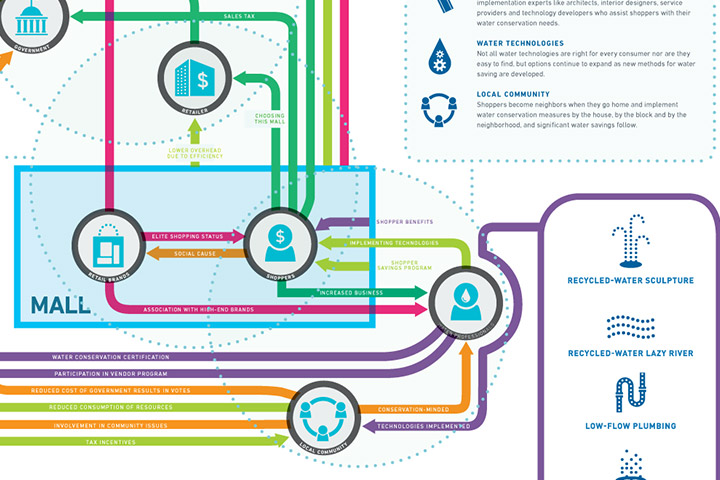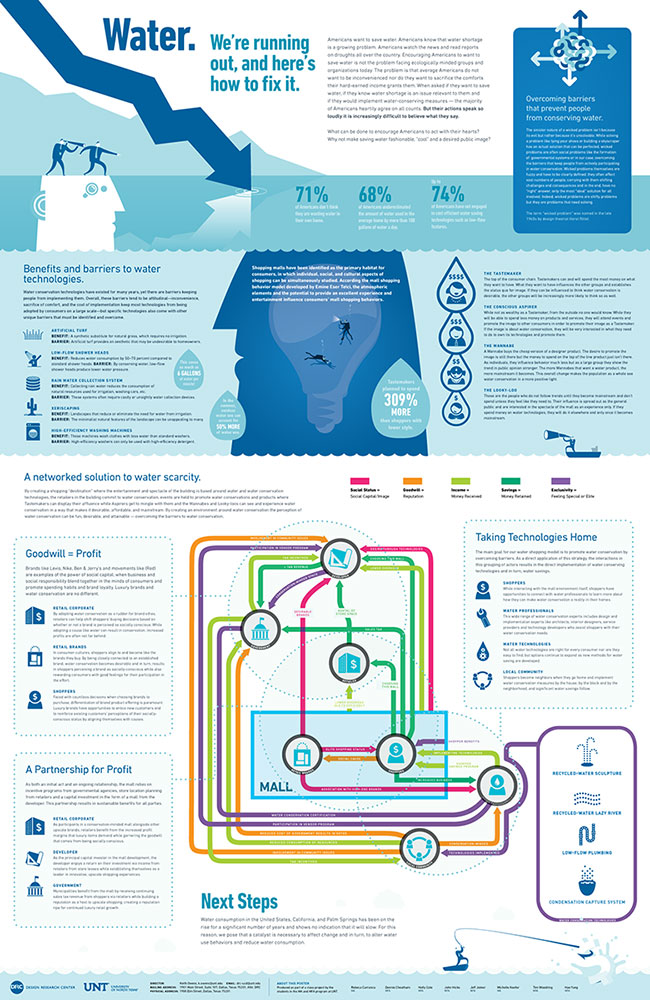Winning Recognition for Water Scarcity Solutions

On March 3, 2013, I joined Applied Design Research M.F.A. Candidate, John Hicks and M.A. Candidate, Michelle Keefer in presenting our research and ensuing solutions for battling water scarcity in the United States. Our research was entered in the Behavioral Sciences category of the First Annual Graduate Exhibition at the University of North Texas and competed against research completed by other masters and doctoral candidates. While John, Michelle, and I presented one poster each, the entire project had been completed in Fall 2012 under Associate Professor Keith Owens by our entire team which also included Beca Carranza (M.A.), Holly Cole (M.F.A.), Jeff Joiner (M.F.A.), Tim Woodring (M.F.A.) and Hao Yang (M.F.A).

Considering the fact that our work was competing in a social science category instead of in the humanities or fine arts, our team was excited to demonstrate Design Research to attendees and judges and to see how well our work would be received. Our team was elated with the outcome of the competition, with the poster I presented winning 2nd place and the poster John presented winning 3rd in our category. After a semester of hard work researching water scarcity and developing a solution that combatted the problem on a behavioral level, it was very rewarding to have our research recognized by our peers and by experts.
Come See Us!
John and I will be presenting and our entire team will be in attendance on the evening of May 2, 2013, at UNT on the Square where winning research from the Graduate Exhibition will be featured and the public will be invited to attend along with UNT administration. I hope to see you there!
Below is an abstract for our research as well as images of the posters which communicate the research.
Water Conservation Can Be Fashionable : An Attitudinal Approach to Reducing Water Overuse in the United States
This research addresses water overuse and the resulting water scarcity experienced in cities in the arid, southwestern portion of the United States by framing the problem as one requiring a shift in personal attitudes versus the improvement of technological solutions. Our research into American attitudes on water conservation has revealed that over the past ten years Americans have expressed an increasing desire to save water though their actions have not revealed their resolve to effect change. For this reason, we believe a catalyst is necessary to begin the work of altering water use behaviors and in turn, to reduce water consumption. In addressing the problem of water scarcity, our team chose Palm Springs, California as a social and ecological environment in which to explore possible solutions that could begin to shape attitudes on water scarcity and overuse. The solution that emerged from our examination of the social stigmas inherent in the region is presented in our poster that explicates the design of a network of connections, relationships, and interactions that stem from a luxury shopping mall dedicated to the advancement of water conservation. We present that this mall, a space for water technology exhibition, socially-conscious brand development, and commerce, could be a catalyst for the shaping of attitudes on water conservation across a network of existing entities because of its alignment of social responsibility with a profit-driven business model that engages luxury brand shoppers’ needs to maintain and advance their personal image and social standing. Our poster exhibits the design of an interoperable web of reciprocal connections between stakeholders such as corporations, small businesses, government, civic organizations, residents, and shoppers that we believe could result in the cause of water conservation becoming more fashionable and desirable because of its association with high-end brands. In turn, we present that by elevating the cause of water conservation in one of the highest trendsetting areas of the country, others who revere these trendsetters may begin to take on their shared ideals and adopt water conservation methods themselves, resulting in increased water conservation regionally and nationally.


